How To Draw A Dog Facing Forward
Whether yous're a dog owner (like myself), you dear dogs or you only want to learn how to make a cute portrait of a canis familiaris, this commodity will for sure help you!
We'll begin by learning most the best way to simplify a dog's head structure so you'll exist able to apply this method to draw whatsoever kind of dog!
What You'll Acquire in this Tutorial
- The structure of a canis familiaris's head
- How to use the construction of our dog's caput for other breeds
- How to detail dog features
- How does domestic dog fur works and how to shade information technology?
Materials Needed for this Guide
- A piece of newspaper
- A graphite pencil from the number HB to 4B
- A graphite pencil from the number 8B (a higher gradation if possible)
- A blending stump / q-tip / piece of towel paper
- An eraser (a Tombow mono naught too if possible)
- A ruler
Here are all the steps in ane image:
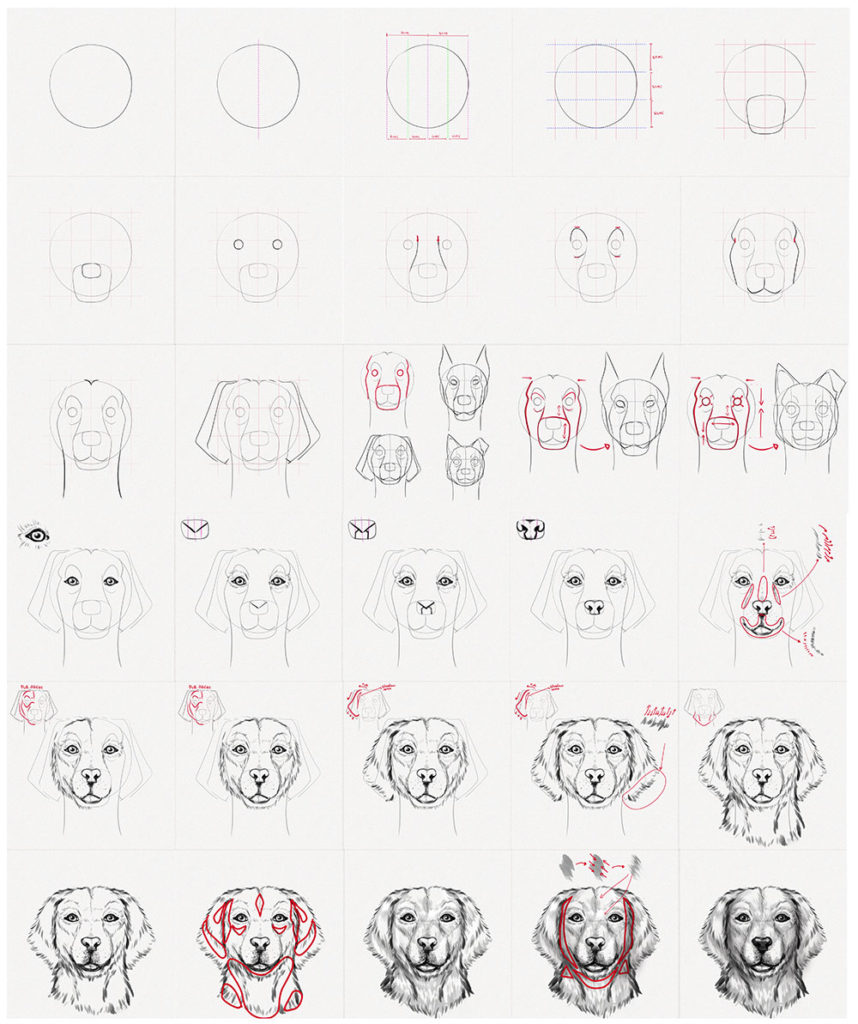
Permit'south begin!
Section ane: The Construction of a Domestic dog's Head
For these steps, we're going to employ a slice of paper (recommended Fabriano newspaper), a soft graphite pencil from the gradation HB to 4B, and an eraser.
Step 1: Draw a circle

Depict a circumvolve in the center of our canvass, This will exist our dog's head (without ears) so make certain to make it as big as y'all want your dog's portrait to be.
Step 2: Find the eye of our circle

Find the eye bespeak of our circle and describe a soft vertical line.
Nosotros're now going to establish a small filigree that'll assistance us draw the structure of our dog's head accurately, make sure to pay attention to the post-obit steps.
Footstep 3: Depict the vertical guidelines

Notice the middle point of each side of the circle and draw a soft vertical line on each side. Brand sure the distance betwixt each line and the borders of our circumvolve are the same.
Step four: Split our circumvolve into 3 equal parts horizontally

I hope this is the concluding step of our filigree, cut the circle horizontally into three equal parts and trace soft lines.
Step v: Describe a rectangle-like shape

This shape will be the nose and oral cavity of our domestic dog. Get in slightly bigger than the space between our start horizontal guidelines and slightly lower than the circle but make sure it fits between our vertical guidelines.
Footstep 6: Depict a smaller rectangular-like shape

This shape will be the nose of our dog, make sure to make it symmetrical taking as reference the central guideline we drew in step ii.
Pace 7: Fix the position of the eyes

Draw two small-scale circles in the position indicated in the example and make certain to align them with the middle of the vertical guidelines.
Step 8: Draw the nose bridge
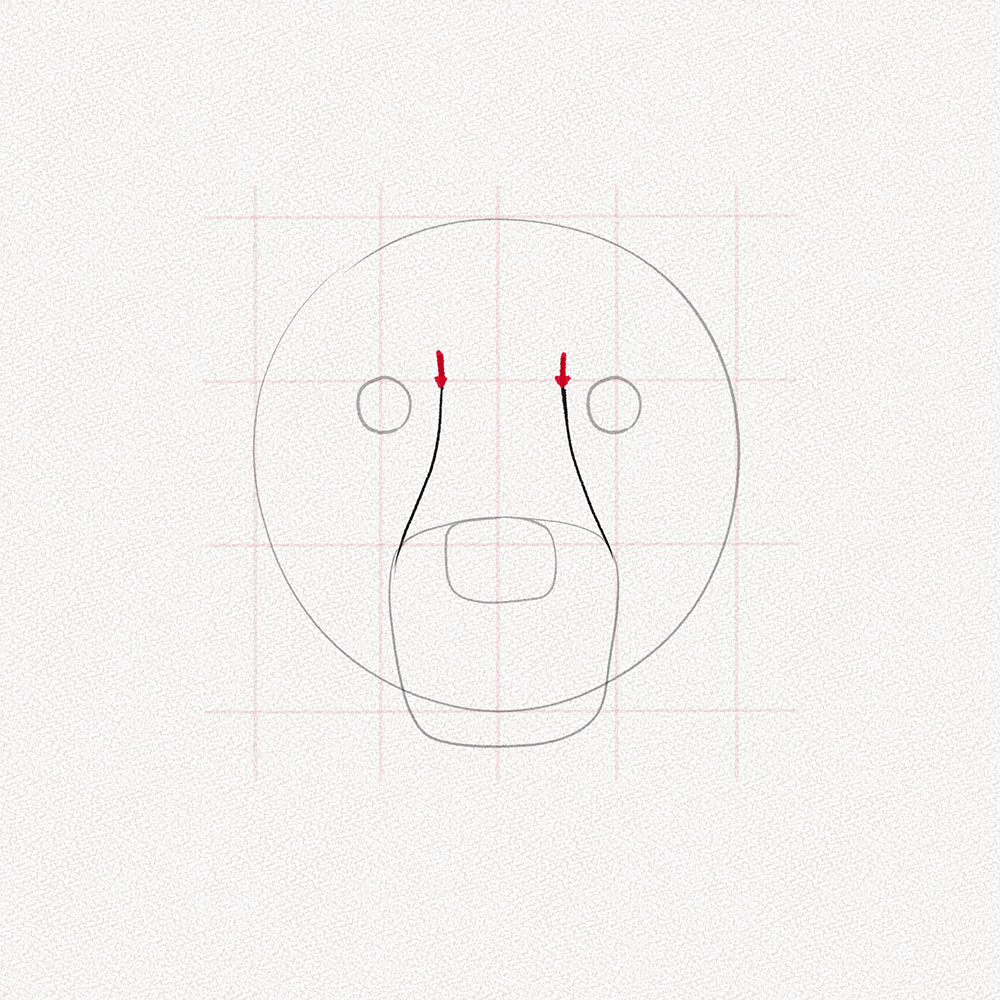
Pull two curved lines from the outer sides of the mouth to the inner side of the eyes, leaving a small gap between them.
Stride 9: Draw the guides for the eyebrows and eyelids
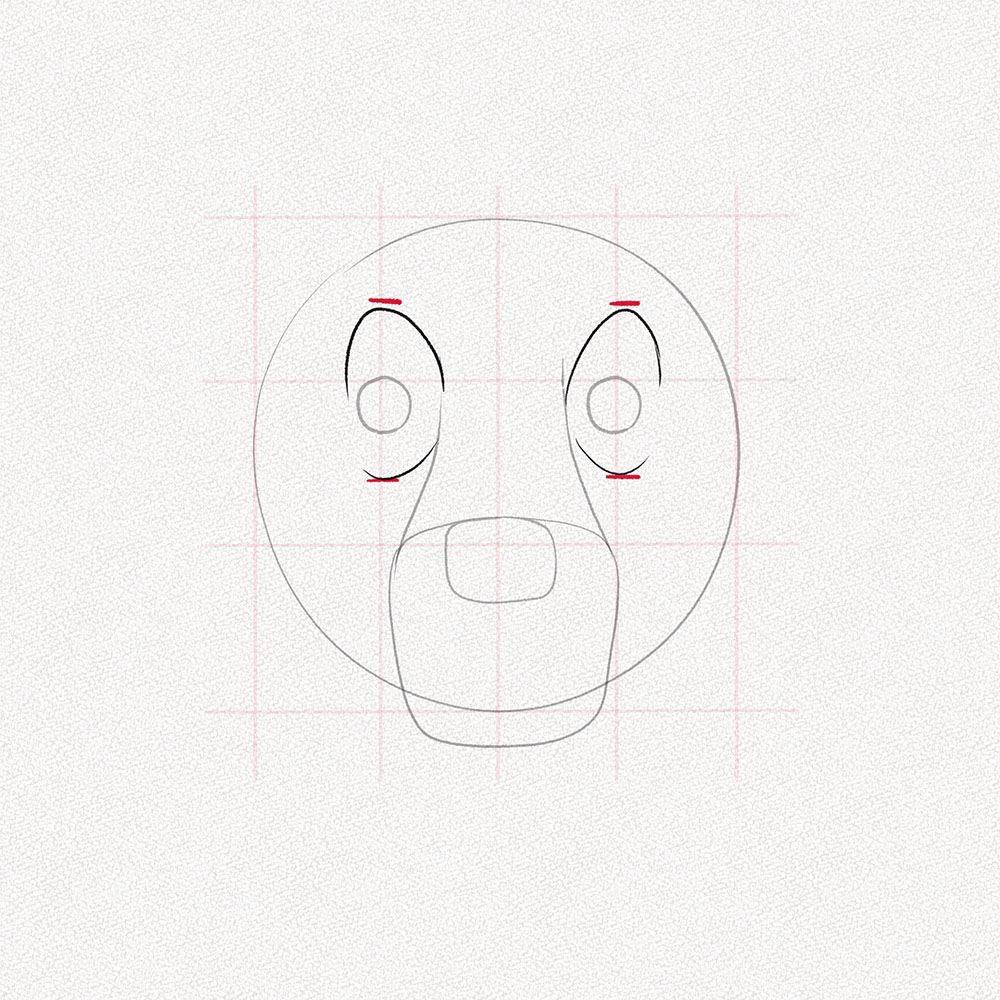
The simplest way to set the guides for our dog'southward eyeballs, eyebrows, and eyelids is to pull two curved lines from the nose bridge to half of the center guidelines, as shown in the instance.
Step 10: Depict the face's construction
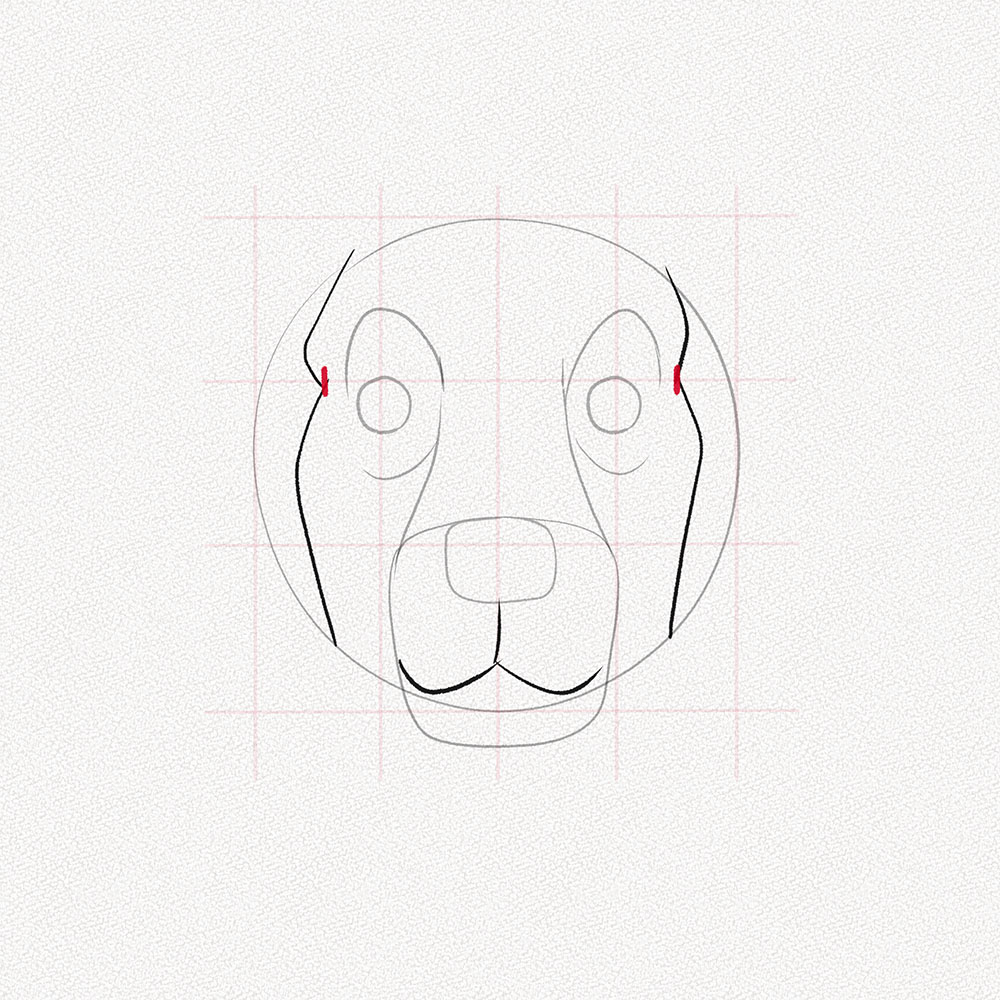
Domestic dog's skulls are quite a bit difficult to simplify, but the best way to show structure in our dog's confront is to set up the guidelines as shown in the case. Depict two curved lines from half of our outer guidelines showing the temple and cheekbones of our dog.
Also, draw the mouth past making an inverse "Y" shape and pulling two curved lines from the extremes.
Pace xi: Draw the neck and define the skull.
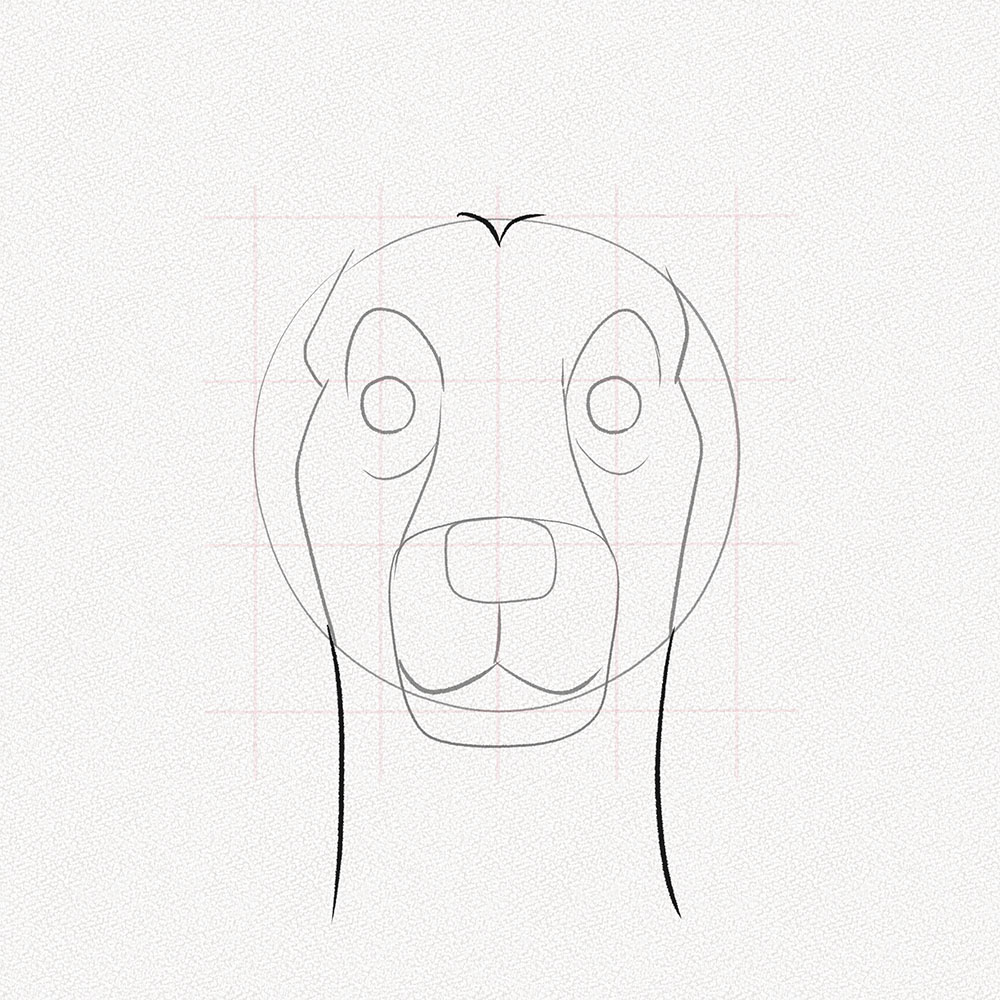
The dog's skull has an indentation that runs from the center to the span of the olfactory organ, we will correspond this shape with two converging curved lines in the middle of the top of the head, and we'll as well depict the neck, pulling down two slight curves from the cheek lines we drew in step 10.
Section two – Choosing a Dog Breed
Footstep 12: Unlike Kind of dogs
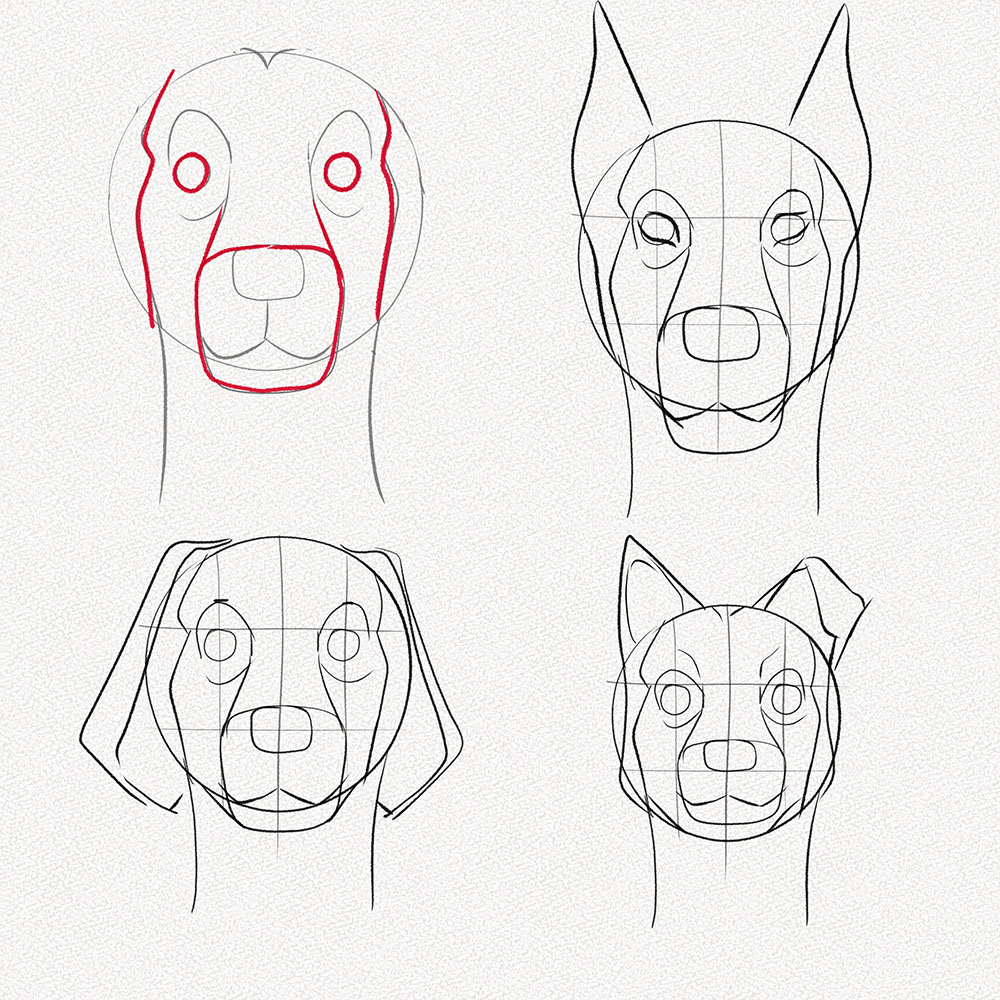
Every domestic dog is different, the ane that volition be drawing in this tutorial is a cute gilded retriever withal, this canis familiaris face structure is good for whatsoever kind of canis familiaris! the just affair you'll take to do is movement around the highlighted shapes. Keep reading to find out how!
Step xiii: Large Dogs
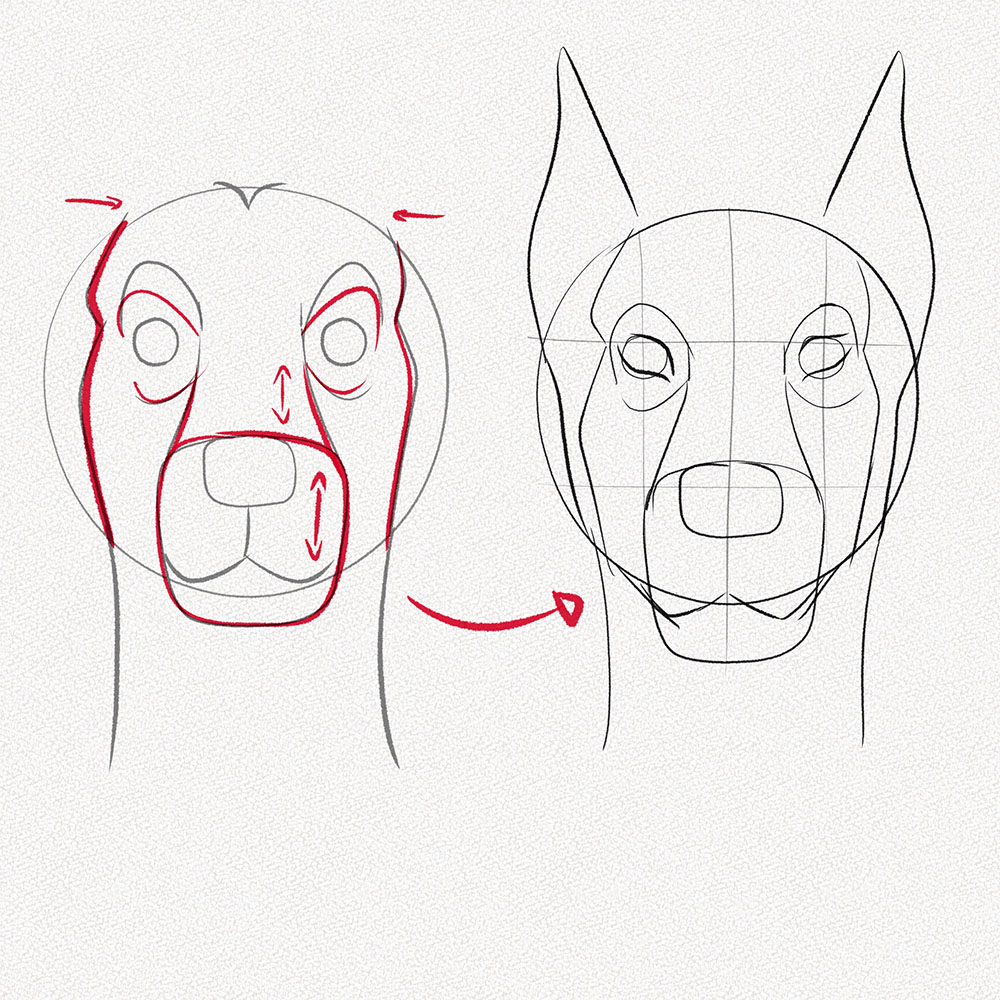
to describe a big canis familiaris like a Doberman, with sharp features and pointy ears all we'd have to exercise is elongate the nose bridge and the mouth shape and shorten the eye features while shortening the space betwixt the structure face up lines, depict the very pointy ears and we're done!
Pace 14: Smaller dogs
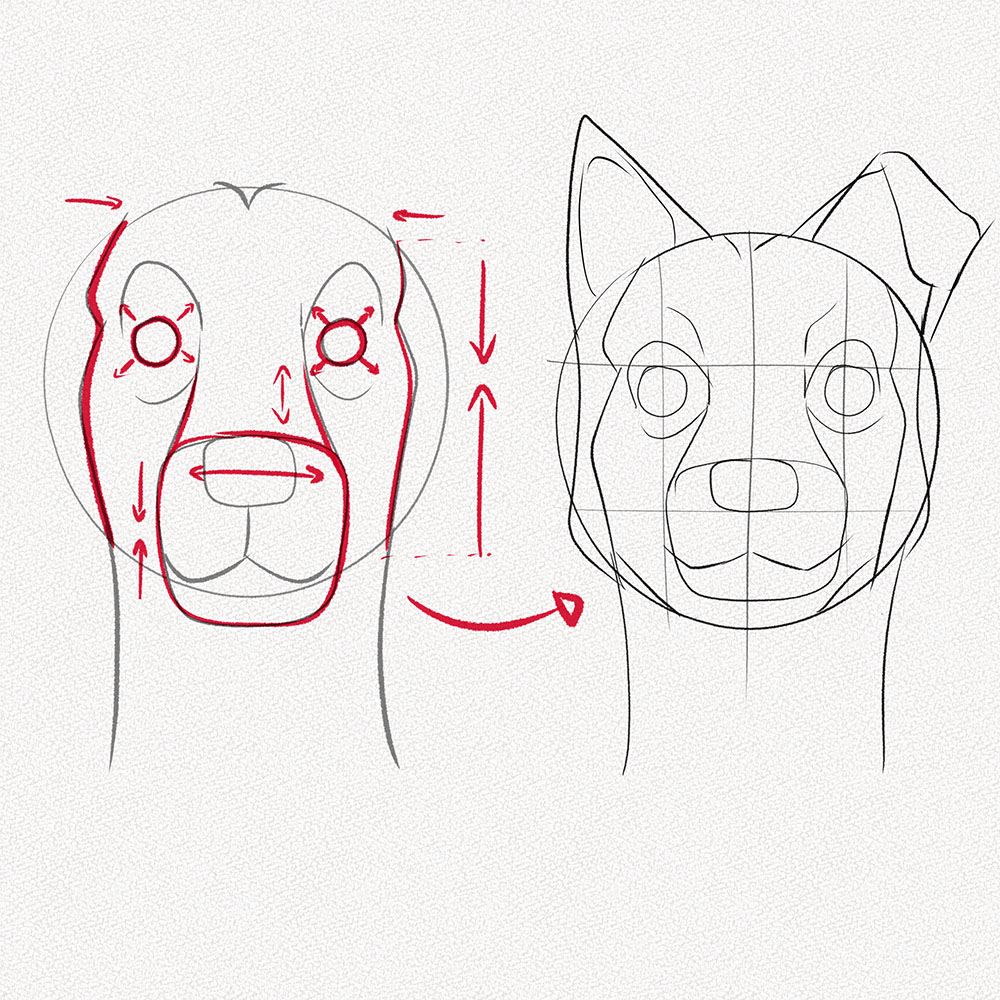
To draw a smaller breed, all we accept to practice is pay attention to their faces and adjust the shapes as we see fit. For this instance, I enlarged the eyes, shortened the face structure lines, widened the nose bridge and rima oris, and drew their bones ear shape.
Footstep 15: The Dog We'll Draw – A Golden Retriever
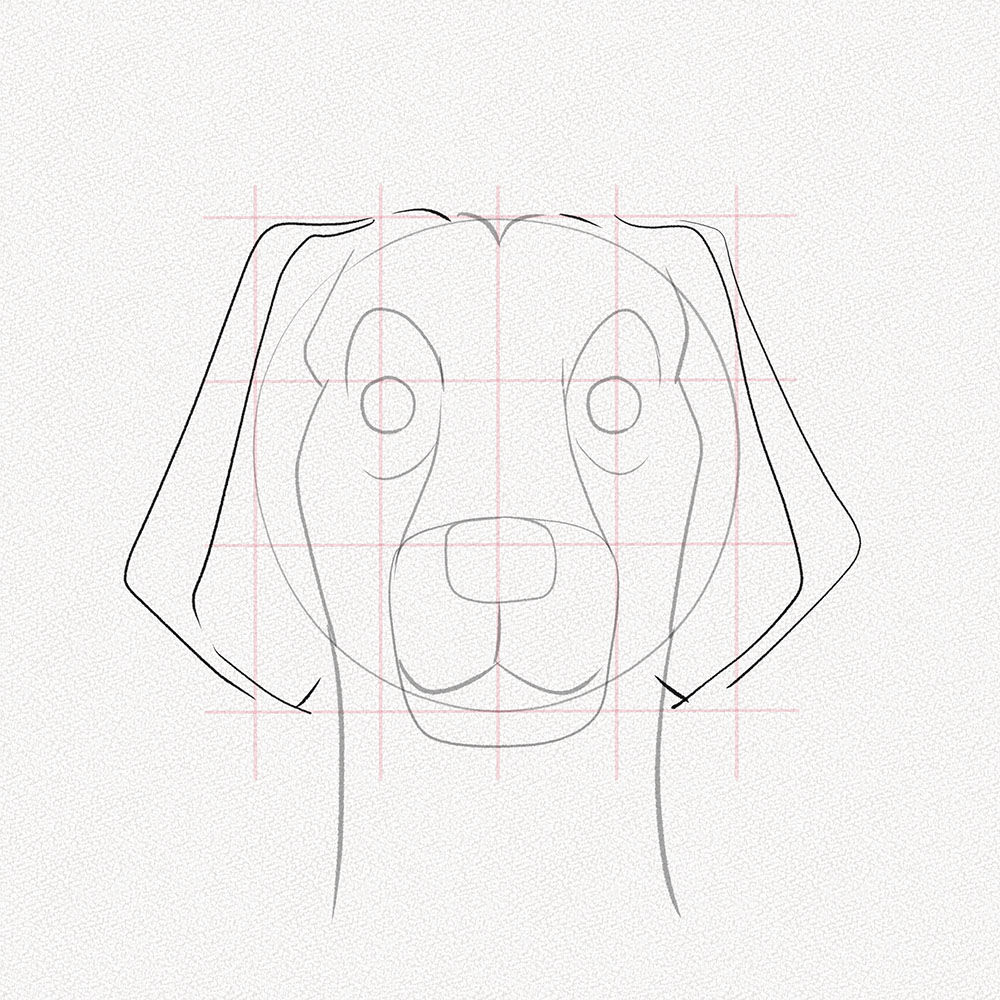
For this tutorial, we are going to draw a gold retriever, not changing the confront structure much, nosotros'll add the feature ear shape of these beautiful dogs and erase our guidelines then we can go ahead and start drawing!
Section 3: How to particular Dog's features
For these steps, nosotros're going to use the 8B graphite pencil or graphite bar.
Step 16: The Dog's Eyes
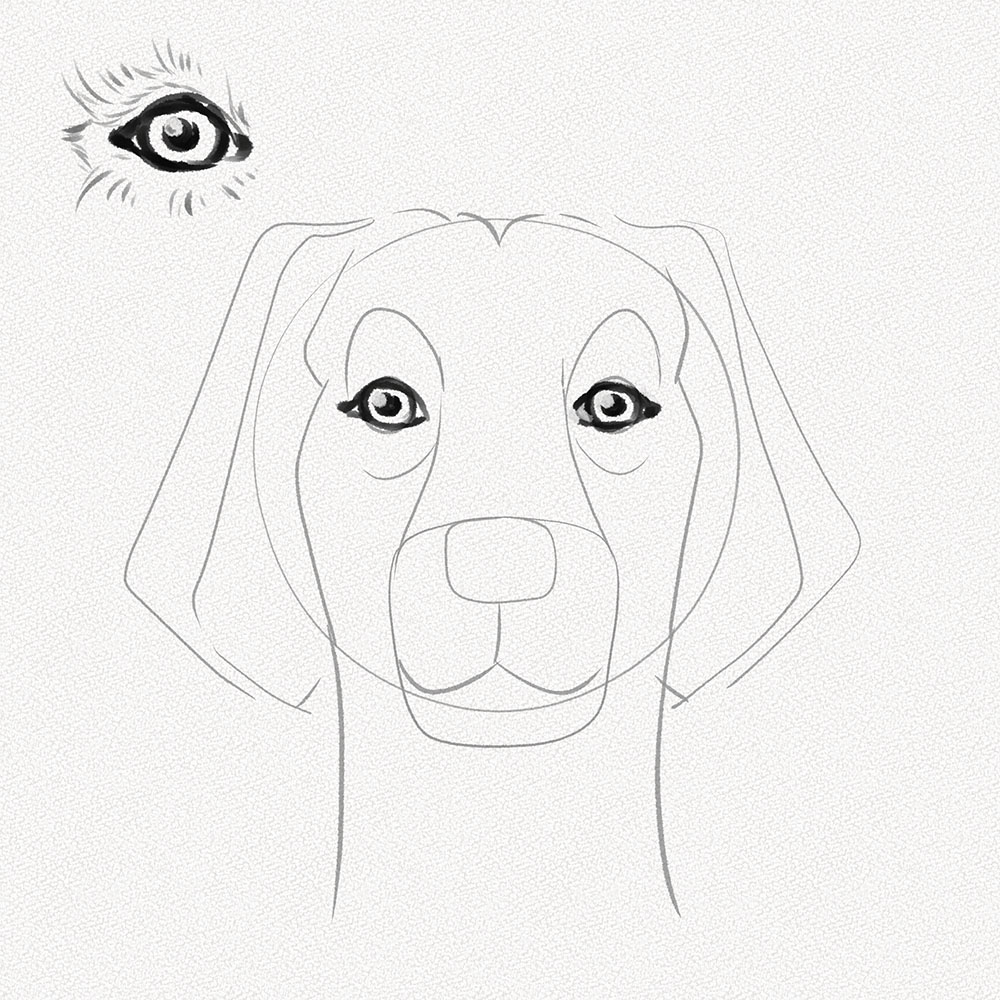
Paying shut attention to our domestic dog's brood (gilded retriever) we're going to make the eyes. Brand sure to add together some fur on superlative of it to demark the eye's structure as well as the eyelids.
Demand to learn how to draw optics? Check out our extremely detailed step-by-step tutorial on How to Draw Eyes.
Step 17: Start Setting the Nose Construction
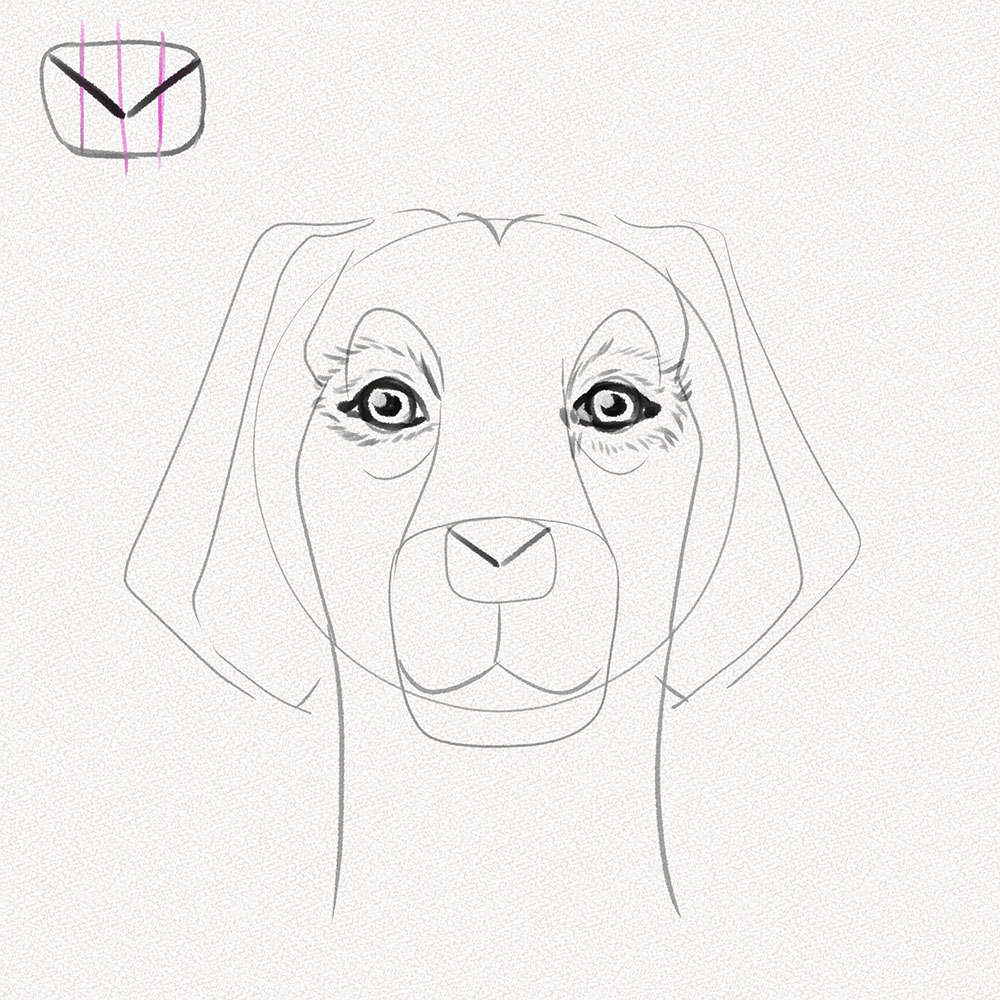
Dog noses are a flake complicated, merely with these tips, you should be able to make it right! Department the canis familiaris's nose shape in 3 equal parts and draw a "Five" grade as shown.
Step 18: Complete the nose structure
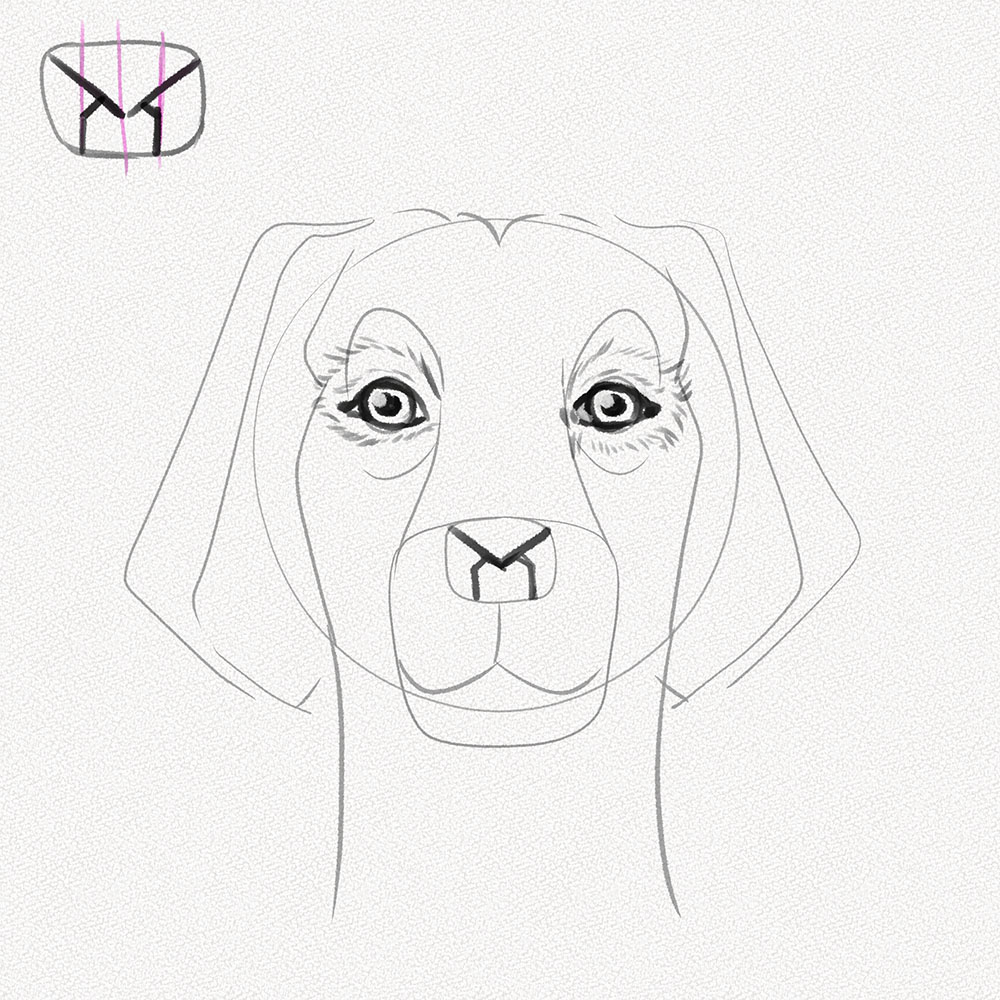
From the sides of that "V" shape, pull two brusque lines to our department guidelines and so another two vertical lines as shown.
Stride 19: Draw half of the nose
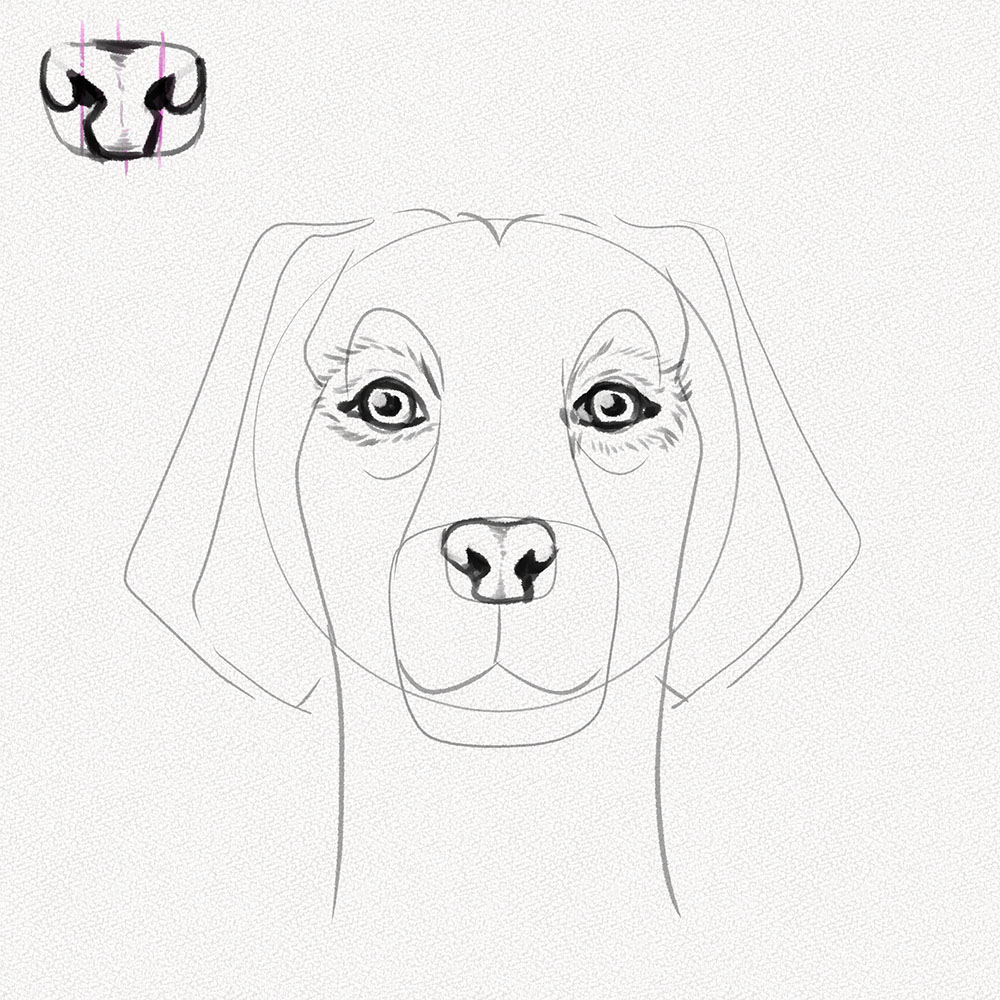
At present it's time to detail using the short like we drew as a guideline, we're going to depict 2 "water drib" like shapes and paint them all black, from the sides of those, pull two small curves to connect them to the peak of our nose and paint the heart line softly
Step 20: Add together fur details to the face up
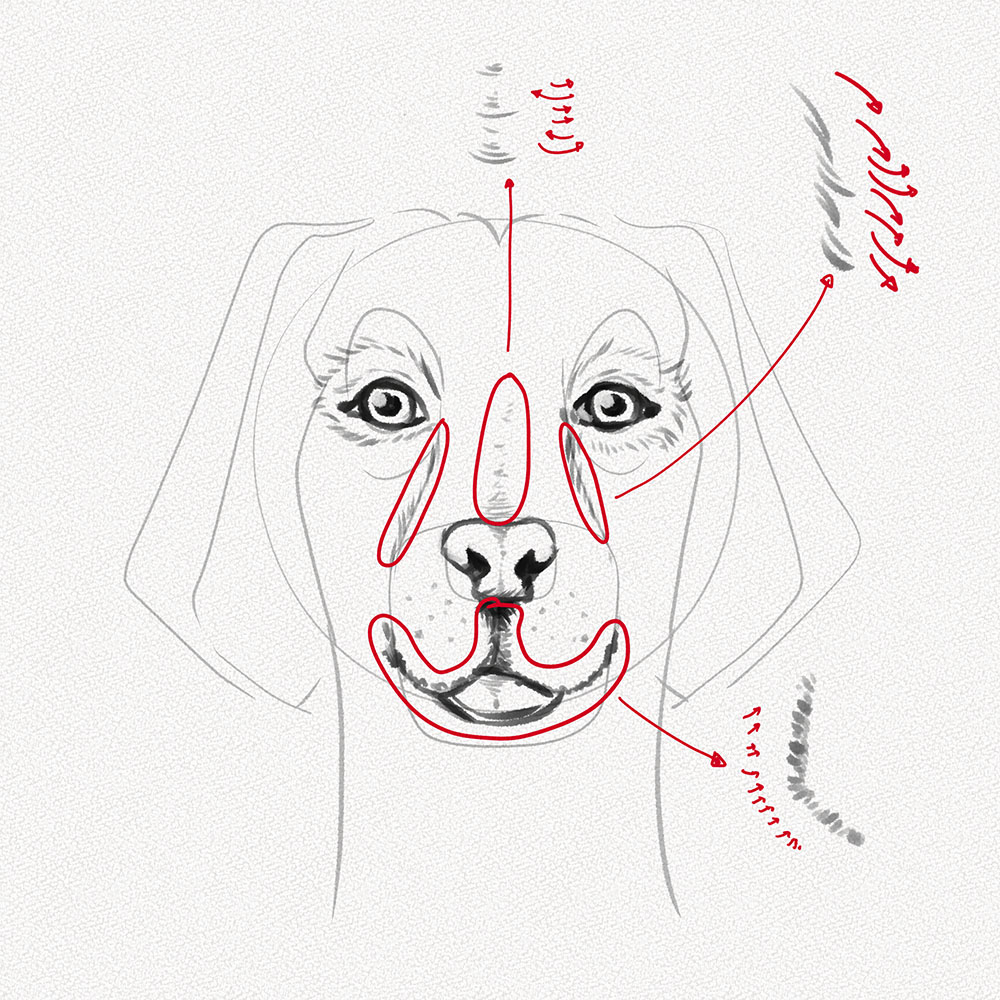
Following the instructions below, add some fur details to the nose span, center of the face up, and mouth, with soft traces going in the directions pointed by the arrows in red as shown.
Section 4: Drawing and Shading Dog Fur
For these steps we're going to utilise or 8B graphite pencil and our blending stump / q-tip / piece of towel paper.
Step 21: Depict more fur to half of the face
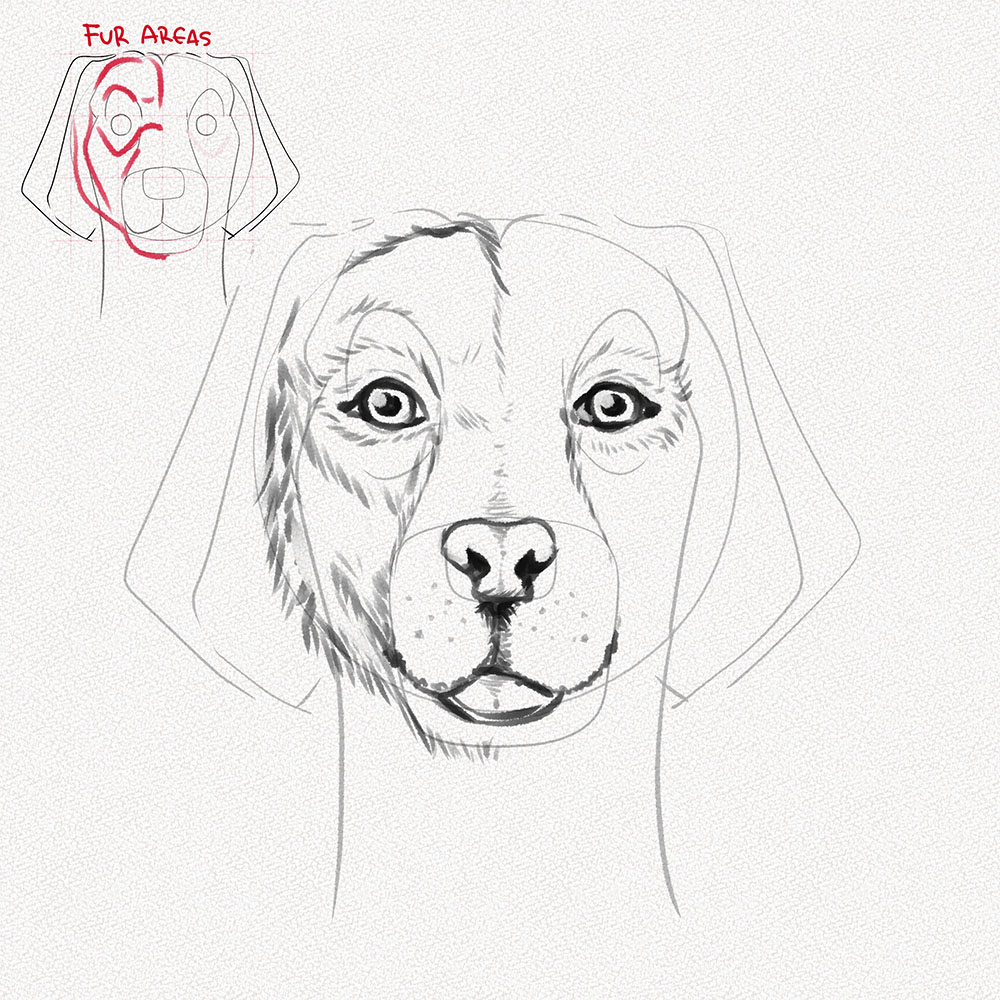
To learn how to identify the canis familiaris's facial fur, we're going to practise half of it first, going on top of the red areas shown in the mini diagram. With heart length, soft traces go over the border of the face and the lines marked in red.
Step 22: Do the other half.
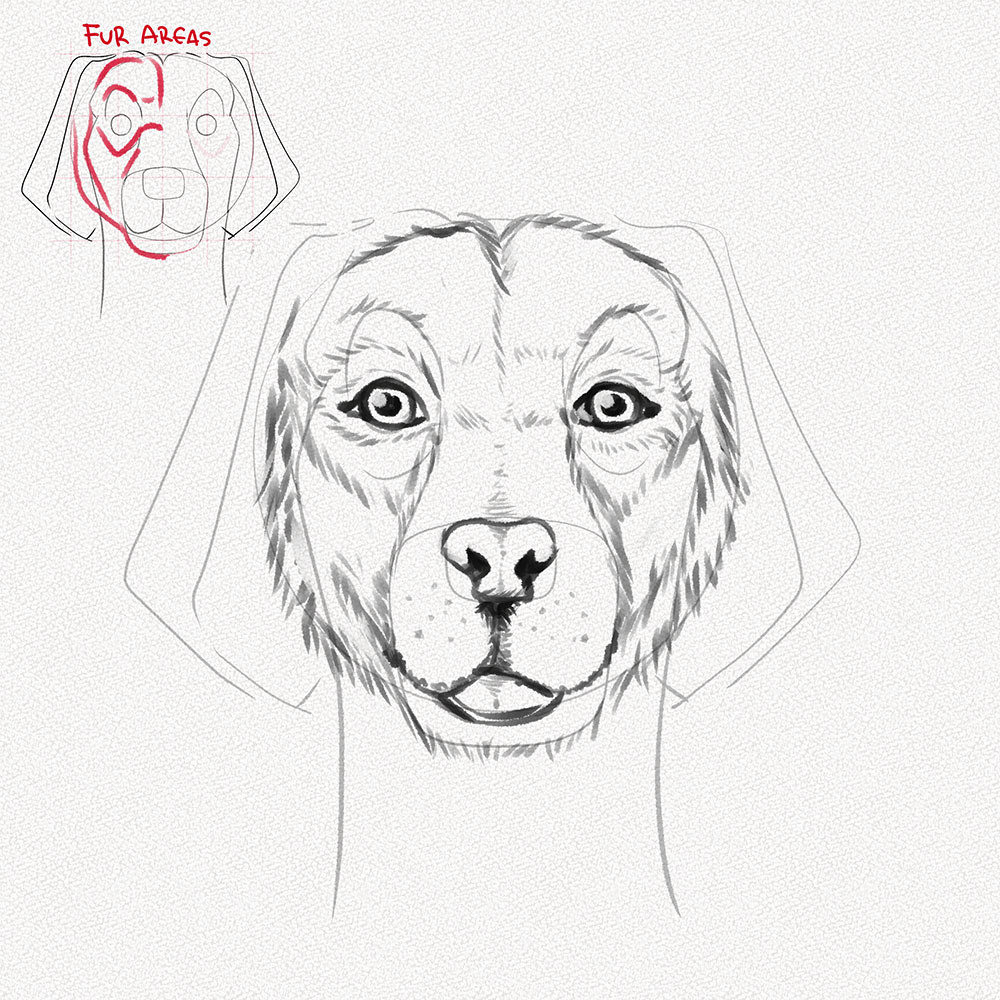
Practice the aforementioned in the other half of the domestic dog's face and we'll have set the base for our dog's face up.
Stride 23: The Dog'south Ears
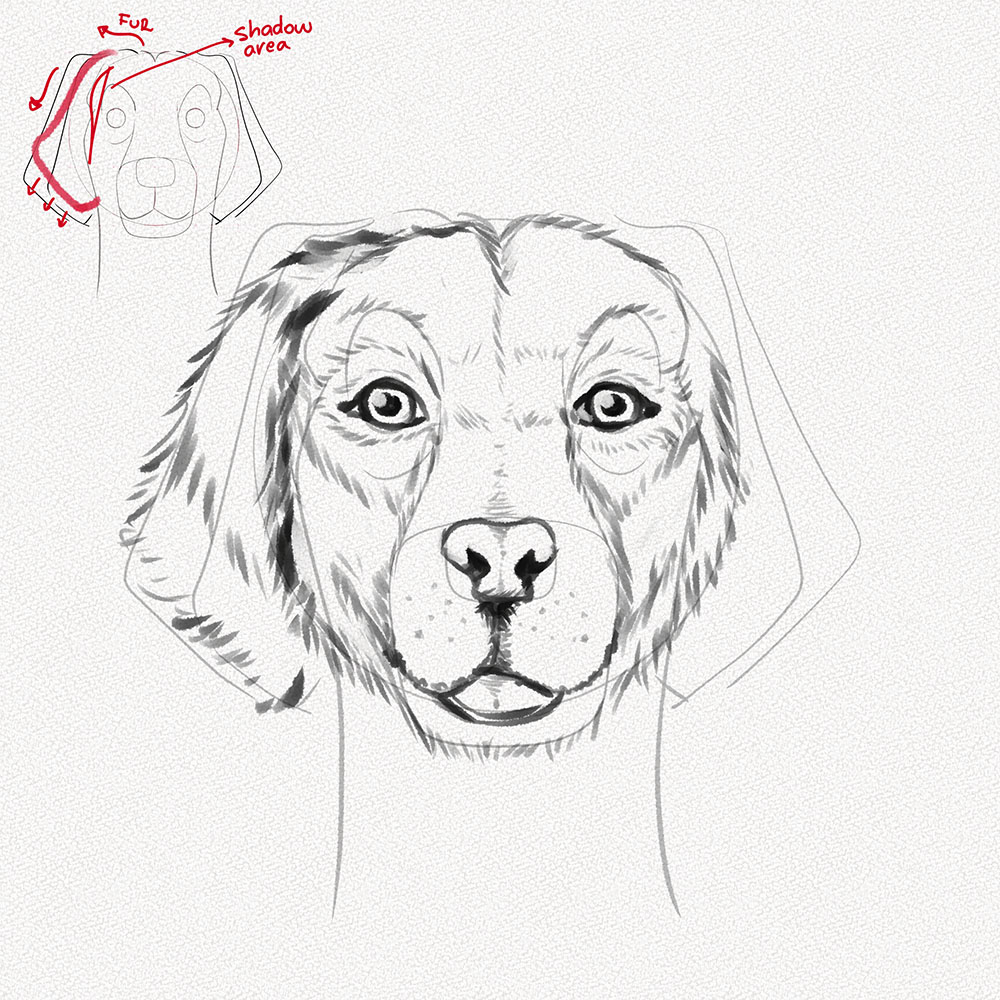
Using our dog as a reference, pull some traces in the directions indicated in the mini diagram, making certain to darken the expanse marked as "shadow area".
Step 24: Draw the Other Ear
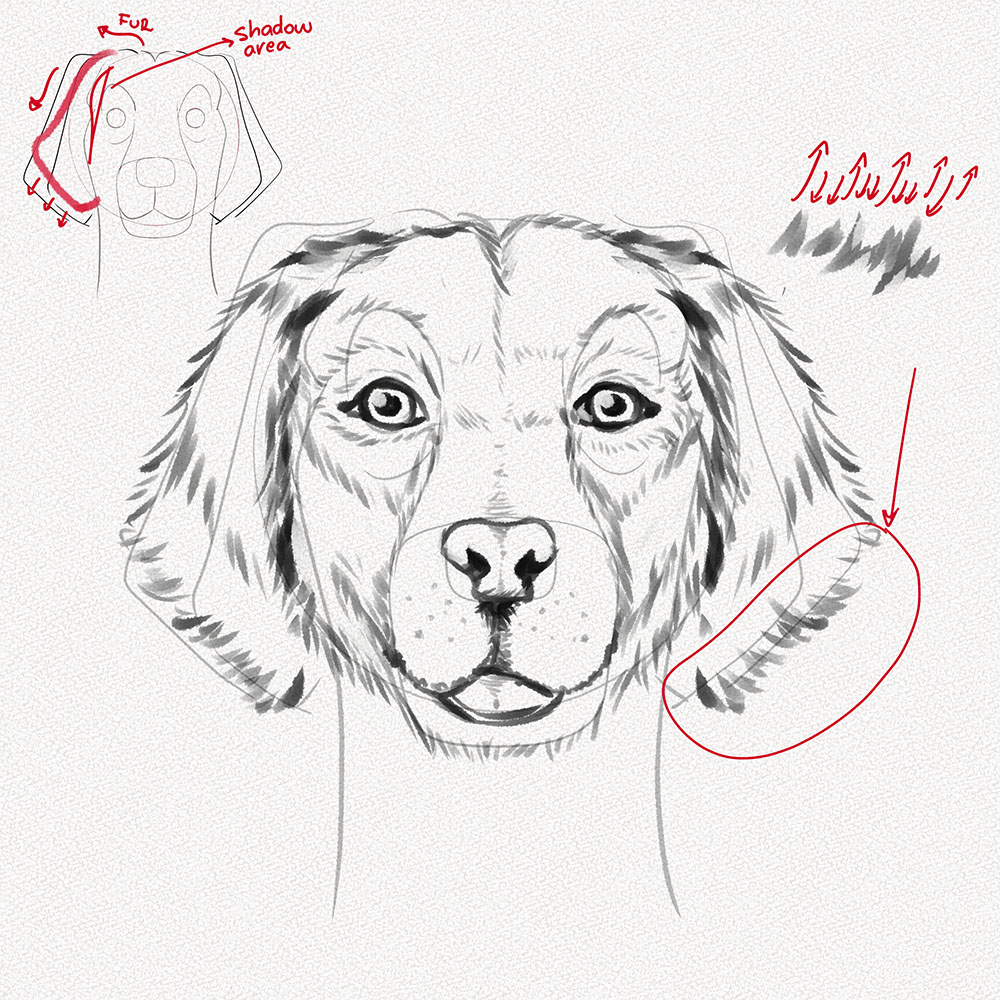
At present for the other ear then exactly the same, and if the fur traces are too complicated, follow the small guide of traces beneath, making sure to continue your paw loose and to do the traces in the indicated directions.
Continue in listen that these traces will help you with making the fur of the balance of the confront.
Step 25: Draw the Neck
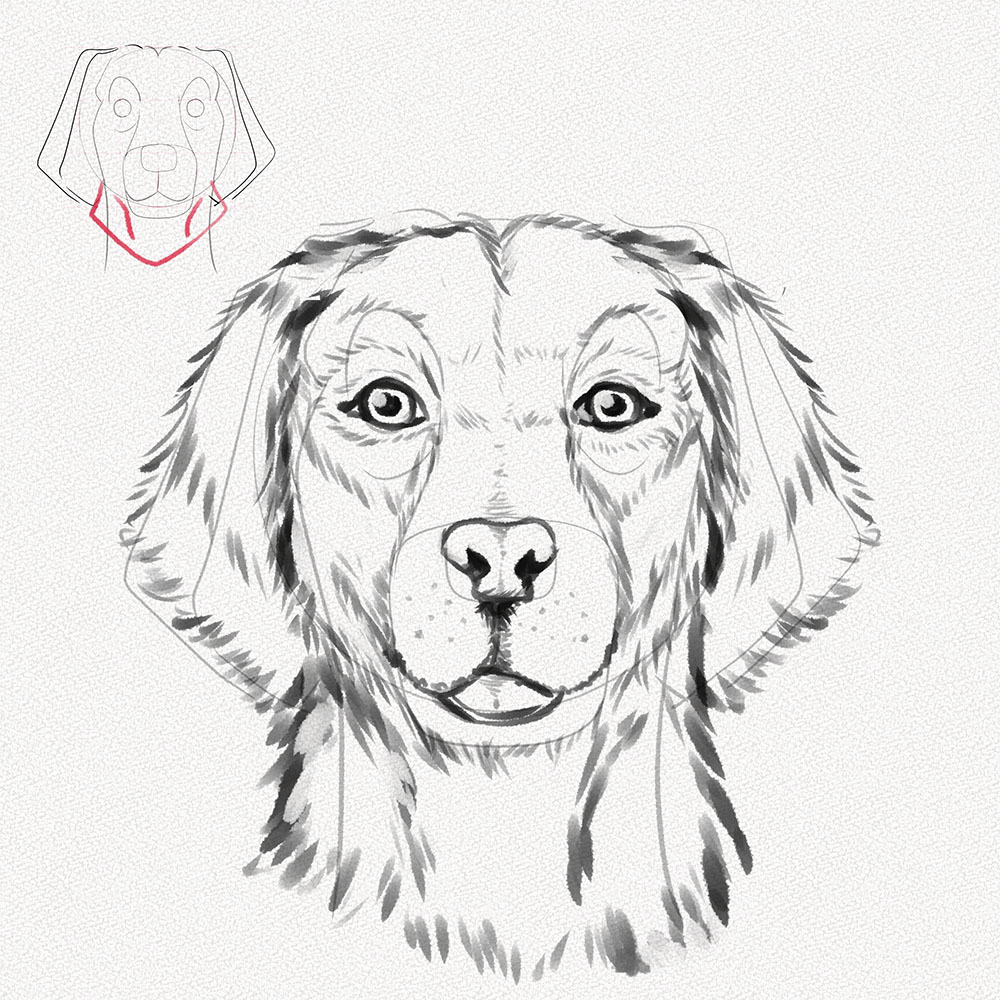
For this step, we're going to use our dog as a reference and draw his fur equally we saw it, for a aureate retriever, the neck extends to the sides, so draw the fur forth the ruby lines in the mini diagram.
Step 26: Focused Shading
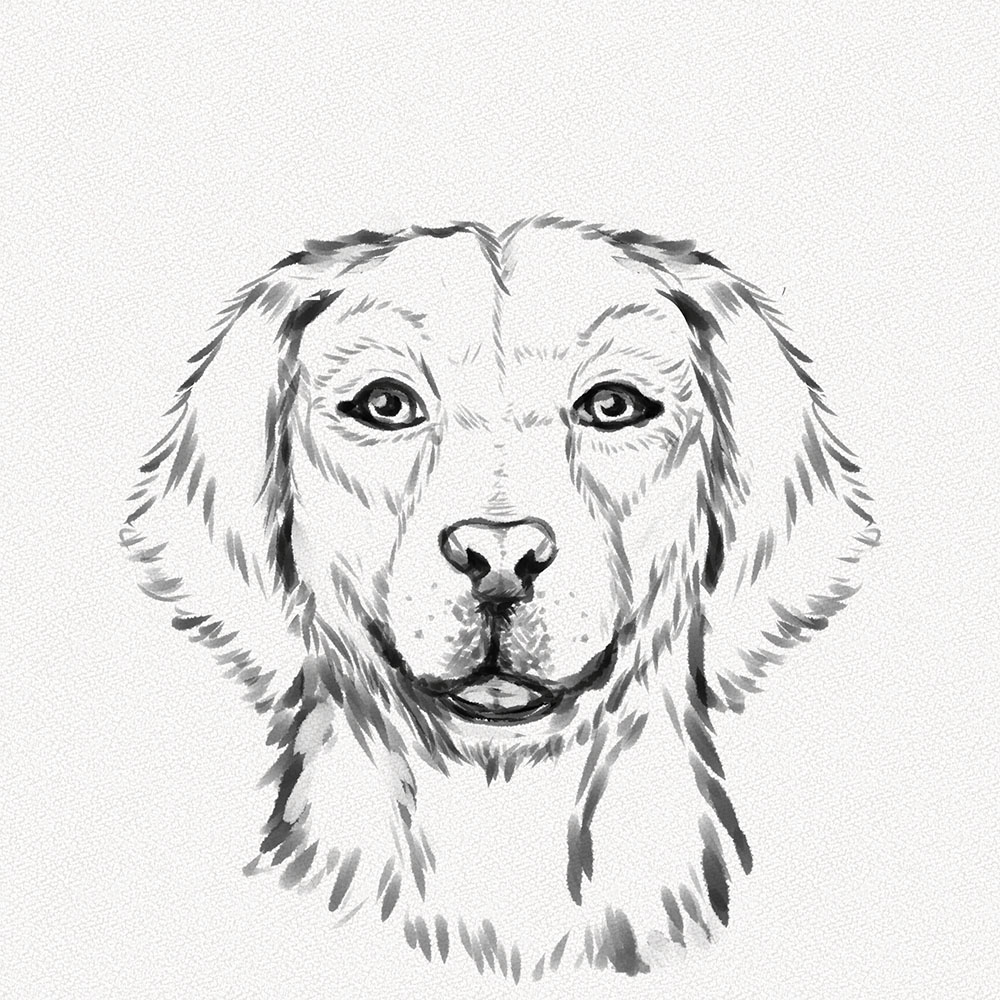
First, we're going to erase what'southward left of our guidelines and add some shadows to the eyes, nose, and upper mouth of our dog. These are pocket-sized details that will make our dog'south face much more realistic.
Since this dog has a bit of his tongue out, we're besides going to shade darker the line nether the tongue and the chin.
Step 27: Add together the rest of the fur
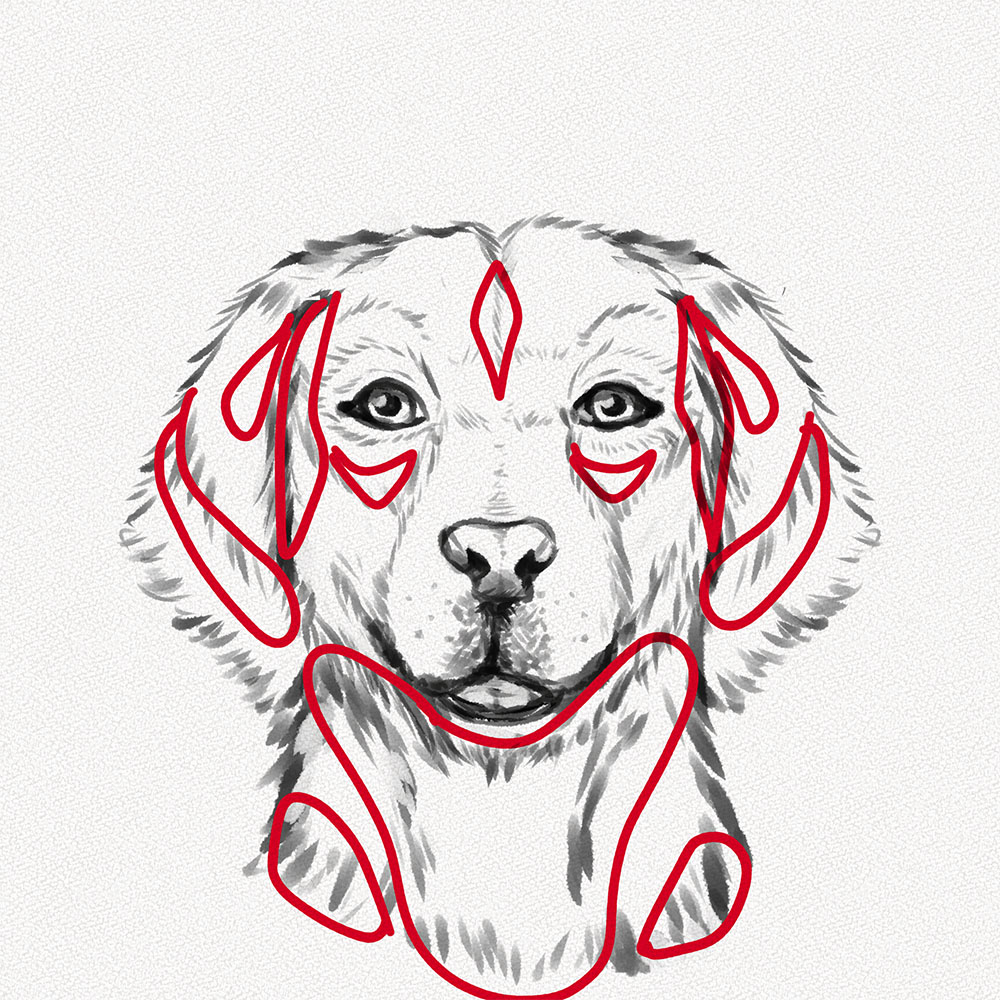
Now, check the areas marked in reddish and with the same soft traces we learned to make in step four, fill in those areas.
Step 28: Blend, blend, and blend.
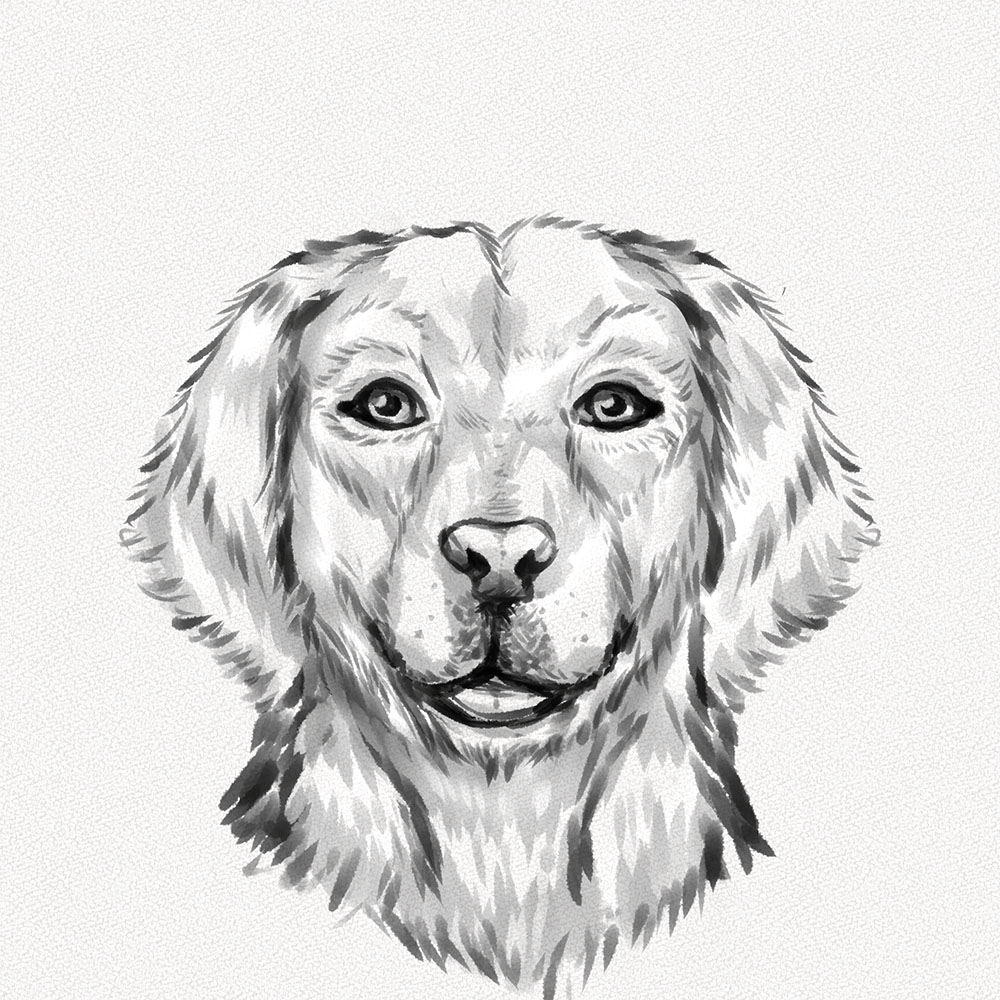
With the movement nosotros learned to make in step 4, nosotros're going to go over our graphite traces and blend with our blending tool, it should look something like this once you're over.
Stride 29: Defining the Facial Fur
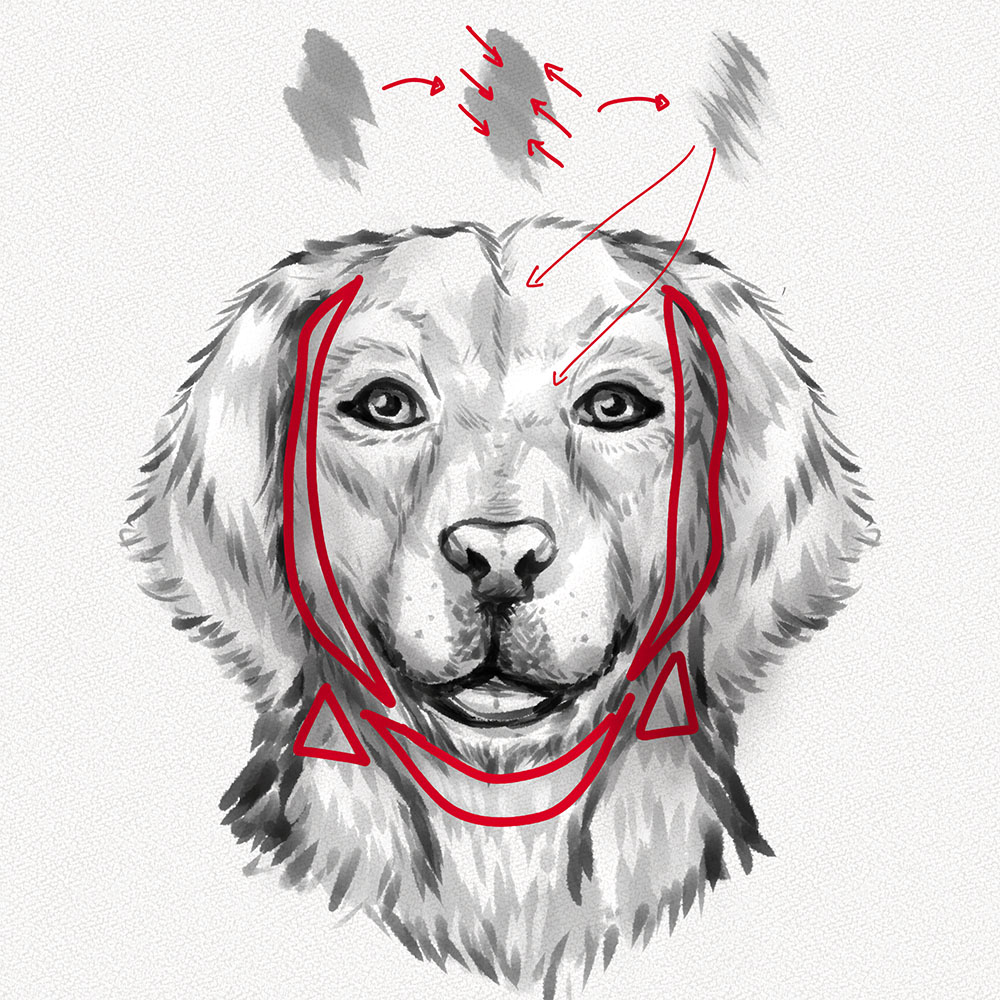
Now it for sure looks a scrap more than similar a dog, we're non done though. With the tip of your eraser, nosotros're going to take the spots we over composite and do as shown beneath, taking away graphite with soft traces to give the illusion of fur.
We're as well going to add together a bit more graphite traces in the red area, to give our dog's portrait more volume.
Stride xxx – Final Stride
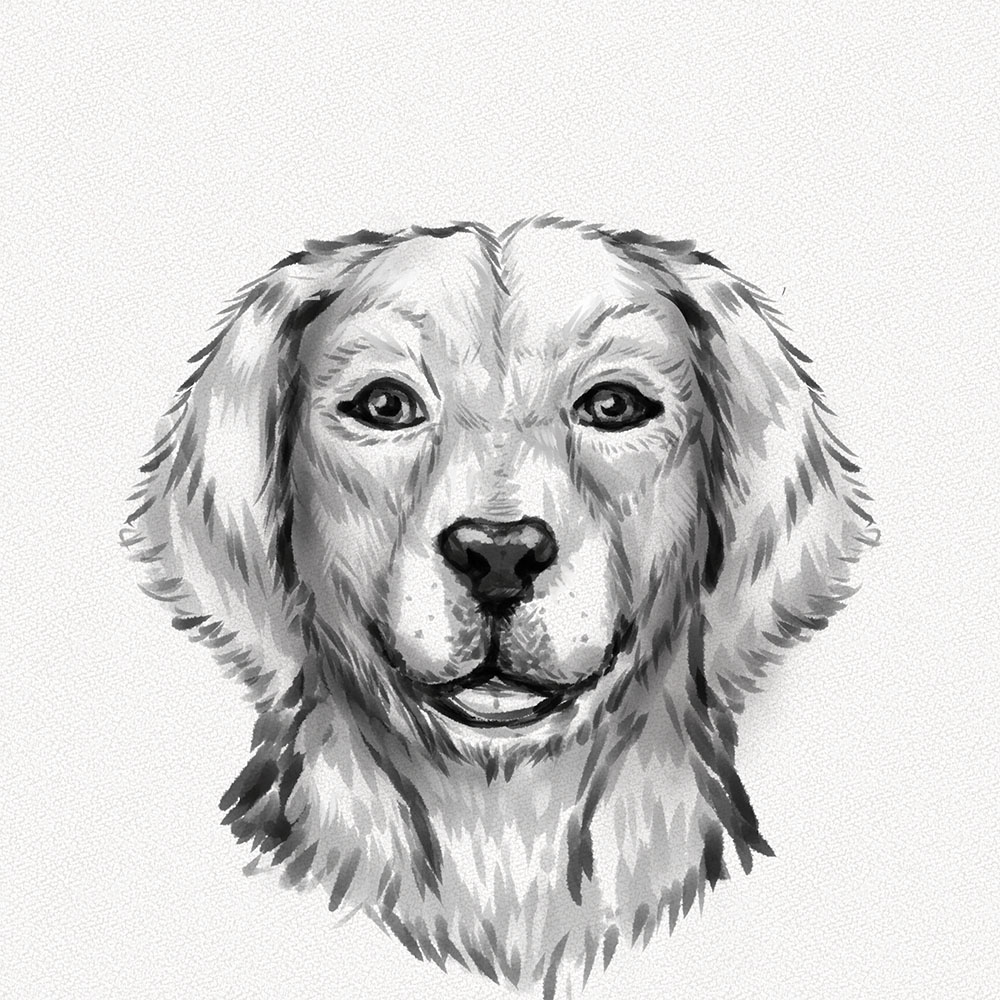
Afterwards nosotros're done blending and correcting, we're going to fill up in the olfactory organ, leaving some unfilled areas at the top for the highlights, and shade our eyes a tad chip more. And that's it! Congrats on totally nailing this!
Thank you for post-obit this tutorial, I hope you had fun drawing this pal!
Source: https://www.artlex.com/art-tutorials/how-to-draw-a-dog-face/
Posted by: foltzchai1944.blogspot.com


0 Response to "How To Draw A Dog Facing Forward"
Post a Comment